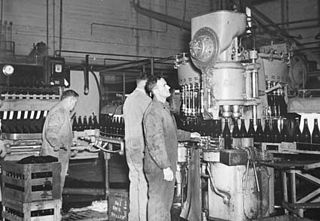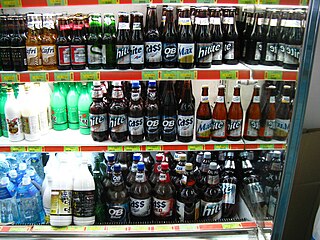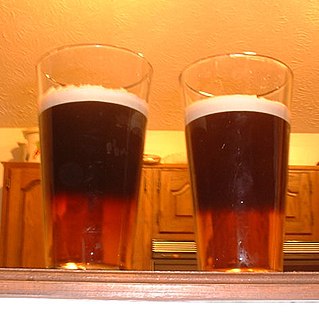
Beer is one of the oldest and most widely consumed alcoholic drinks in the world, and the third most popular drink overall after water and tea. It is produced by the brewing and fermentation of starches, mainly derived from cereal grains—most commonly from malted barley, though wheat, maize (corn), rice, and oats are also used. During the brewing process, fermentation of the starch sugars in the wort produces ethanol and carbonation in the resulting beer. Most modern beer is brewed with hops, which add bitterness and other flavours and act as a natural preservative and stabilizing agent. Other flavouring agents such as gruit, herbs, or fruits may be included or used instead of hops. In commercial brewing, the natural carbonation effect is often removed during processing and replaced with forced carbonation.

The Campaign for Real Ale (CAMRA) is an independent voluntary consumer organisation headquartered in St Albans, England, which promotes what they designate as "real" ale, "real" cider, "real" perry and traditional British pubs and clubs. With just under 160,000 members, it is the largest single-issue consumer group in the UK, and is a founding member of the European Beer Consumers Union (EBCU).

A pub is an establishment licensed to serve alcoholic drinks for consumption on the premises. The term public house first appeared in the late 17th century, and was used to differentiate private houses from those which were, quite literally, open to the public as "alehouses", "taverns" and "inns". By Georgian times, it had become common parlance, although taverns, as a distinct establishment, had largely ceased to exist by the beginning of the 19th century. Today, pubs have no strict definition, but CAMRA states a pub has four characteristics:
- is open to the public without membership or residency
- serves draught beer or cider without requiring food be consumed
- has at least one indoor area not laid out for meals
- allows drinks to be bought at a bar

Newcastle Brown Ale is a brown ale, originally brewed in Newcastle upon Tyne, England. Launched in 1927 by Colonel Jim Porter after three years of development, the 1960 merger of Newcastle Breweries with Scottish Brewers afforded the beer national distribution and sales peaked in the United Kingdom in the early 1970s. The beer underwent a resurgence in the late 1980s and early 1990s with student unions selling it. By the late 1990s, the beer was the most widely distributed alcoholic product in the UK. By the 2000s, the majority of sales were in the United States, although it still sells 100 million bottles annually in the UK. Brewing moved in 2005 from Newcastle to Dunston, Tyne and Wear, in 2010 to Tadcaster, and in 2017 to the Heineken Brewery in Zoeterwoude, the Netherlands. As of 2019, it is also brewed by Lagunitas Brewing Company in Petaluma, California, and Chicago, Illinois, for the American market.

A boilermaker can refer to two types of beer cocktail. In American terminology, the drink consists of a glass of beer mixed with a shot of whiskey.

Drinking culture is the set of traditions and social behaviors that surround the consumption of alcoholic beverages as a recreational drug and social lubricant. Although alcoholic beverages and social attitudes toward drinking vary around the world, nearly every civilization has independently discovered the processes of brewing beer, fermenting wine and distilling spirits.

A beer tap is a valve, specifically a tap, for controlling the release of beer. While other kinds of tap may be called faucet, valve or spigot, the use of tap for beer is almost universal. This may be because the word was originally coined for the wooden valve in traditional barrels. Beer served from a tap is largely known as draught beer, though beer served from a cask is more commonly called cask ale, while beer from a keg may specifically be called keg beer. Beer taps can be also used to serve similar drinks like cider or long drinks.

A toast is a ritual during which a drink is taken as an expression of honor or goodwill. The term may be applied to the person or thing so honored, the drink taken, or the verbal expression accompanying the drink. Thus, a person could be "the toast of the evening", for whom someone "proposes a toast" to congratulate and for whom a third person "toasts" in agreement. The ritual forms the basis of the literary and performance genre, of which Mark Twain's "To the Babies" is a well-known example.

St. James's Gate Brewery is a brewery founded in 1759 in Dublin, Ireland, by Arthur Guinness. The company is now a part of Diageo, a company formed from the merger of Guinness and Grand Metropolitan in 1997. The main product of the brewery is Guinness Draught.

Beer has been brewed in England for thousands of years. As a beer brewing country, it is known for top fermented cask beer which finishes maturing in the cellar of the pub rather than at the brewery and is served with only natural carbonation.

Beer arrived in Australia at the beginning of British colonisation. In 2004 Australia was ranked fourth internationally in per capita beer consumption, at around 110 litres per year; although, the nation ranked considerably lower in a World Health Organization report of alcohol consumption per capita of 12.2 litres. Lager is by far the most popular type of beer consumed in Australia.

Beer, called maekju in Korean, was first introduced to Korea in the early 20th century. Seoul's first beer brewery opened in 1908. Two current major breweries date back to the 1930s. The third brewery established in Korea, Jinro Coors Brewery, was founded in the 1990s. It was later acquired by Oriental Breweries (OB). Hite Breweries's former name was Chosun Breweries, which was established in 1933. The company changed its name to Hite Breweries in 1998. OB Breweries established as Showa Kirin Breweries in 1933. The company changed its name to OB Breweries in 1995.

Beer glassware comprise vessels made of glass, designed or commonly used for serving and drinking beer. Styles of glassware vary in accord with national or regional traditions; legal or customary requirements regarding serving measures and fill lines; such practicalities as breakage avoidance in washing, stacking or storage; commercial promotion by breweries; artistic or cultural expression in folk art or as novelty items or usage in drinking games; or to complement, to enhance, or to otherwise affect a particular type of beer's temperature, appearance and aroma, as in the case of its head. Drinking vessels intended for beer are made from a variety of materials other than glass, including pottery, pewter, and wood.

The Turf Tavern is a historic pub in central Oxford, England. Its foundations and use as a malt house and drinking tavern date back to 1381. The low-beamed front bar area was put in place sometime in the 17th century. It was originally called the Spotted Cow but the name was changed in 1842, likely as part of an effort to extinguish its reputation as a venue for illegal gambling activities.

A drinking establishment is a business whose primary function is the serving of alcoholic beverages for consumption on the premises. Some establishments may also serve food, or have entertainment, but their main purpose is to serve alcoholic beverages. There are different types of drinking establishment ranging from seedy bars or nightclubs, sometimes termed "dive bars", to 5,000 seat beer halls and elegant places of entertainment for the elite. A public house, informally known as a "pub", is an establishment licensed to serve alcoholic drinks for consumption on the premises in countries and regions of British influence. Although the terms are increasingly used to refer to the same thing, there is a difference between pubs, bars, inns, taverns and lounges where alcohol is served commercially. A tavern or pot-house is, loosely, a place of business where people gather to drink alcoholic beverages and, more than likely, also be served food, though not licensed to put up guests. The word derives from the Latin taberna and the Greek ταβέρνα/taverna.

Guinness is an Irish dry stout that originated in the brewery of Arthur Guinness at St. James's Gate, Dublin, Ireland, in 1759. It is one of the most successful alcohol brands worldwide, brewed in almost 50 countries, and available in over 120. Sales in 2011 amounted to 850 million litres (190,000,000 imp gal). In spite of declining consumption since 2001, it is the best-selling alcoholic drink in Ireland where Guinness & Co. Brewery makes almost €2 billion worth of beer annually.

A black and tan is a beer cocktail made by layering a pale beer and a dark beer. In Ireland, the drink is called a half and half.
Beer Day Britain is an annual event celebrating beer in the United Kingdom. The date has been celebrated annually on 15 June since 2015. It is supported by the British Beer and Pub Association, the Society of Independent Brewers (SIBA), and the Campaign for Real Ale (CAMRA).
Gilroy's Brewery is a microbrewery and restaurant in Muldersdrift, Gauteng, South Africa. The brewery was founded in 2000 by Stephen Gilroy at his pharmaceutical printing company in Roodepoort, Gauteng. Gilroy's Brewery was one of the first microbreweries in South Africa, along with Mitchell's Brewery, Nottingham Road Brewery, and Drayman's Brewery. In 2008 the operation was relocated to the current premises at Ngwenya Glass Village in Muldersdrift, where it expanded to include the restaurant, beer garden, and a gift shop. The brewery produces 5 styles of beer – a lager, pale ale, ruby ale, and a dark ale. The brewery has recently introduced a ginger beer.


















